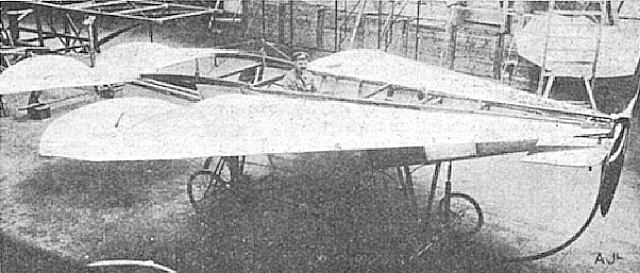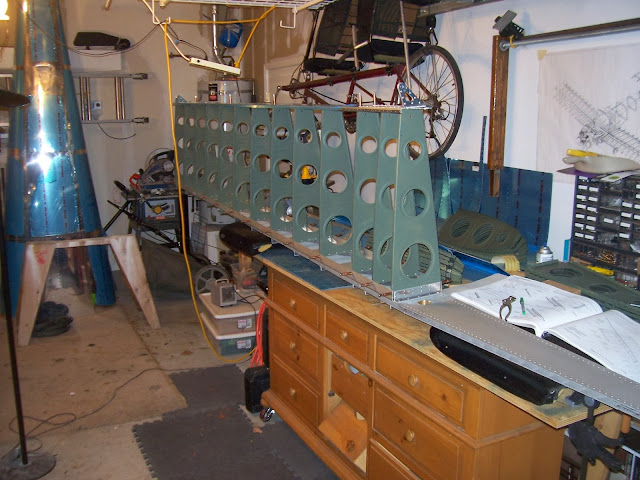Most of the nose ribs went on easily enough but a few of the inboard ones were tricky because, as you can see in the photo below, there's not enough room to get the rivet tool square on the rivets.
 So once again we use the wedge-thingy to squeeze the rivets at an angle. Problem I had is that it typically takes two or three squeezes to "pop" the rivet and between squeezes when the tension is relaxed the wedge wants to turn 90 degrees or so on the rivet mandrel "heavy"-side down, which is unhelpful and annoying. Some of the factory holes in the main wing spar had to be reamed out a little with a #30 fluted reamer beforehand in order to get the LP4-4 rivets to go in the hole.
So once again we use the wedge-thingy to squeeze the rivets at an angle. Problem I had is that it typically takes two or three squeezes to "pop" the rivet and between squeezes when the tension is relaxed the wedge wants to turn 90 degrees or so on the rivet mandrel "heavy"-side down, which is unhelpful and annoying. Some of the factory holes in the main wing spar had to be reamed out a little with a #30 fluted reamer beforehand in order to get the LP4-4 rivets to go in the hole. All of the rivet mandrels broke off clean where they were supposed to and the rivet heads were tight on the flanges, which means I didn't have to drill any out and re-do them, which would have been difficult because there's no room to get my fat DeWalt drill in there. Overall it went well.
Having read the warnings of fellow builder-bloggers to follow plan directions very carefully here, it was with some consternation that I noted the instruction on pp 15-05, Figure 1 to use W-1208 -R FWD AND AFT TRIMMED [RIB] WITH 3 ATTACHED NUTPLATES on the last (most inboard) nose rib. The rib I had prepped for this location only had one nutplate on it and a small doubler plate. How the heck did I screw that up? I desperately scanned other builder blogs but no-one else mentioned a problem. So I called Vans builder support Christmas eve before closing and confirmed that it was bascially a typo. Apparently the rib-prep instructions on pp 15-02, Step 9, Figure 4 had been revised in 2011 to add one nutplate and a doubler (instead of three nutplates and no doubler), but the figure on pp 15-05 (indicating three nutplates instead of one on that rib) hadn't been revised, at least not in my set of plans. That was a relief! Just wish someone on VAF had mentioned it. Although fairly minor, builders on VAF will often mention these sorts of things to keep other builders from getting too worked up, especially on weekends, evenings, and holidays when Vans is closed. Ah well.
_________________________________________________________________________
December 30, 2013 Update:
Here's the e-mail I sent Christmas Eve morning to Vans:
Dear Vans:
On pp 15-02, Step 9 & Figure 4, we are instructed to add a doubler plate and a nut plate to a L and R fwd rib trimmed fore and aft. Note that there is just one K1000-08 nut plate in Figure 4.
Now moving ahead to pp 15-05, Step 5, we are to attach a
trimmed forward R rib with attached nutplates (plural). (No mention of the doubler plate). It
is the last (i.e., most inboard) rib to go on the L wing. Figure 1
seems to show two nutplates, and the leaderline says W-1208-R FWD AND AFT TRIMMED WITH 3 ATTACHED
NUTPLATES. Page 15-02 was revised 7/12/2011, page 15-05 has not been revised.
I either made a mistake and grabbed the wrong rib,
misread the instructions & missed or a step, or else I am
seriously confused. But I think it might be an error on the drawing.
Question: Is the
inboard-most fwd rib on the W-1206-L wing spar supposed to have one nutplate, two nutplates, or three,
and is it supposed to have the small doubler plate on it?
Thanks for getting back to me.
Merry Christmas
The 3 nutplates went away when the new blue wing root
connectors were adopted. A couple drawings have yet to catch up. One doubler, one nutplate.





